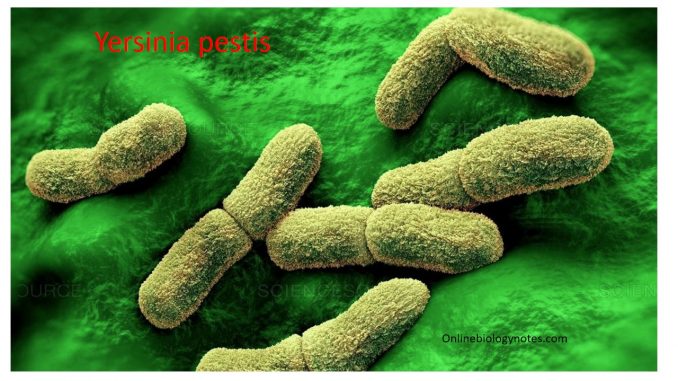
Yersinia pestis
- The name Yersinia is given after the French bacteriologist Alexander Yersinia who discovered the organism causing plague in 1894.
- At present 11 species of Yersinia are known and only 3 species (Y. pestis, Y. enterocolitica and Y. pseudotuberculosis) are pathogenic to humans. Other species can occasionally cause opportunistic infection in humans.
- Yersinia Pestis (formerly Pasteurella pestis) causes plague (black death)
General characteristics:
- Yersinia pestis is a Gram-negative, coccobacilli, about (1.5 X 0.7) mm in size, arranged singly in short chains or in small groups.
- When stained with Giemsa or methylene blue, it shows bipolar staining with two ends densely stained and the central area clear.
- Polymorphism is very common in old cultures, involution forms are seen as coccoid, club shaped, filamentous and giant forms. This involution in culture can be enhanced in media containing 3 % NaCl.
- The bacterium is non-motile, non-spore forming and non-acid fast.
- Capsules are present but may be seen in cultures grown at 37 degree Celsius rather than at the optimum temperature of 27 degree Celsius.
Habitat:
- Y. pestis are found in many wild animals like dog, squirrels, rabbits, mice etc.
Virulence factors:
- The virulence factors that contributes to the pathogenesis of Y pestis is complex.
- These are encoded both on the organism’s chromosomes and on large plasmids.
1. Plague toxin:
- The Plague toxin refers to endotoxin and murine toxins found in culture filtrates or cell lysates
- i. Endotoxin:
- It is a di-polysaccharide found in the cell wall and is responsible for many of the systemic manifestation of the disease caused by Y pestis.
- ii. Murine toxins:
- These are proteins in nature possessing some properties of both exotoxins and endotoxins.
- They are thermolabile and may be toxoided.
- They are released only by the lysis of the cell.
- These toxins are active in rats and mice but not in guinea pigs, rabbits and primates.
- On injection they produce local edema and neurosis with systemic effects on the peripheral vascular system and liver.
2. F1 antigens:
- It is a heat labile protein produced only in the virulent strains when cultures are incubated at 37 degree Celsius.
- Production of this antigen is mediated by plasmid. It inhibits phagocytosis and plays an important role in conferring protective immunity in humans and in mice.
3. V and W antigens:
- These two antigens are always present together V antigen is a protein of molecular weight 90 Kilo-Dalton while W antigen is an acidic 145 K-Da lipoprotein.
- These two antigens are produced by the virulent strains of Y pestis when grown at 37 degree Celsius in the presence of low concentration of calcium.
- These virulence factors inhibit phagocytosis and intracellular killing of bacterium inside macrophages.
4. Type III secretion system (TTSS):
- TTSS consists of many proteins, which facilitates secretion of virulence factors of Y pestis into host cells.
- TTSS mediates the bacteria to resist phagocytic killing.
- It also inhibits production of cytokines, which in turn reduces the inflammatory immune response to infection.
5. Other virulence factors:
- Yersinia produces enzymes such as coagulase, fibrinolysin plasmalogen activator protease, which contributes to virulence of the bacterium.
- PIA degrades c3b and c5a components of the complement, thereby preventing opsonization and phagocytic migration respectively.
- The enzymes also degrade fibrin clots thereby facilitating the organism to spread rapidly.
6. The virulence of the bacterium is enhanced further by its ability to absorb organic iron as a result of a siderophore independent mechanism.
7. Virulence also appears to be associated with an unidentified surface component which absorbs hemin and basic aromatic dyes in culture to form colored colonies.
8. Virulence has also been associated with the ability for persuasive synthesis.
Typing:
Based on the fermentation of glycerol and reduction of nitrate Y. pestis has been found of three distinct types:
| Biotypes | Nitrate reduction | Glycerol fermentation |
| Y pestis var. orientalis | + | – |
| Y pestis var Antigua | + | – |
| Y pestis var mediaevalis | – | + |
